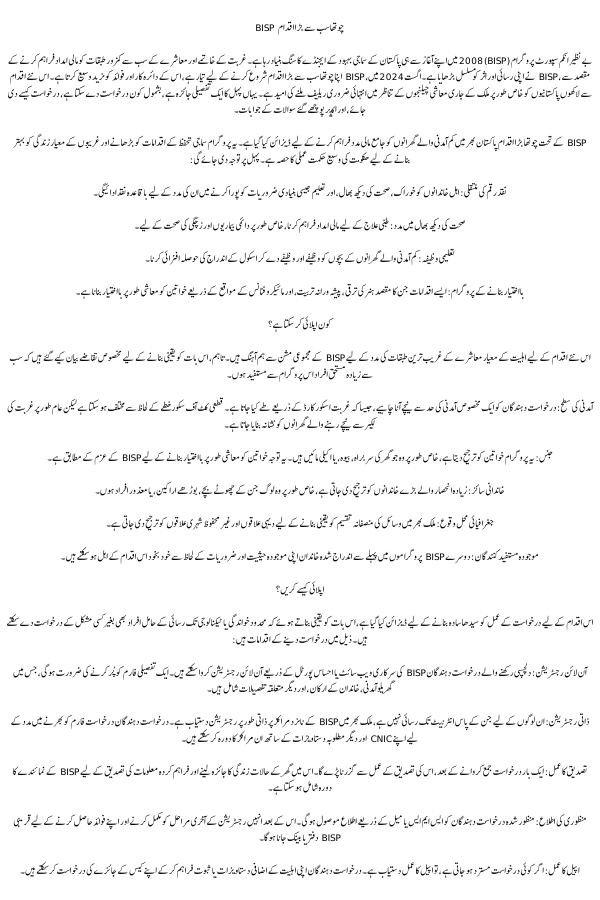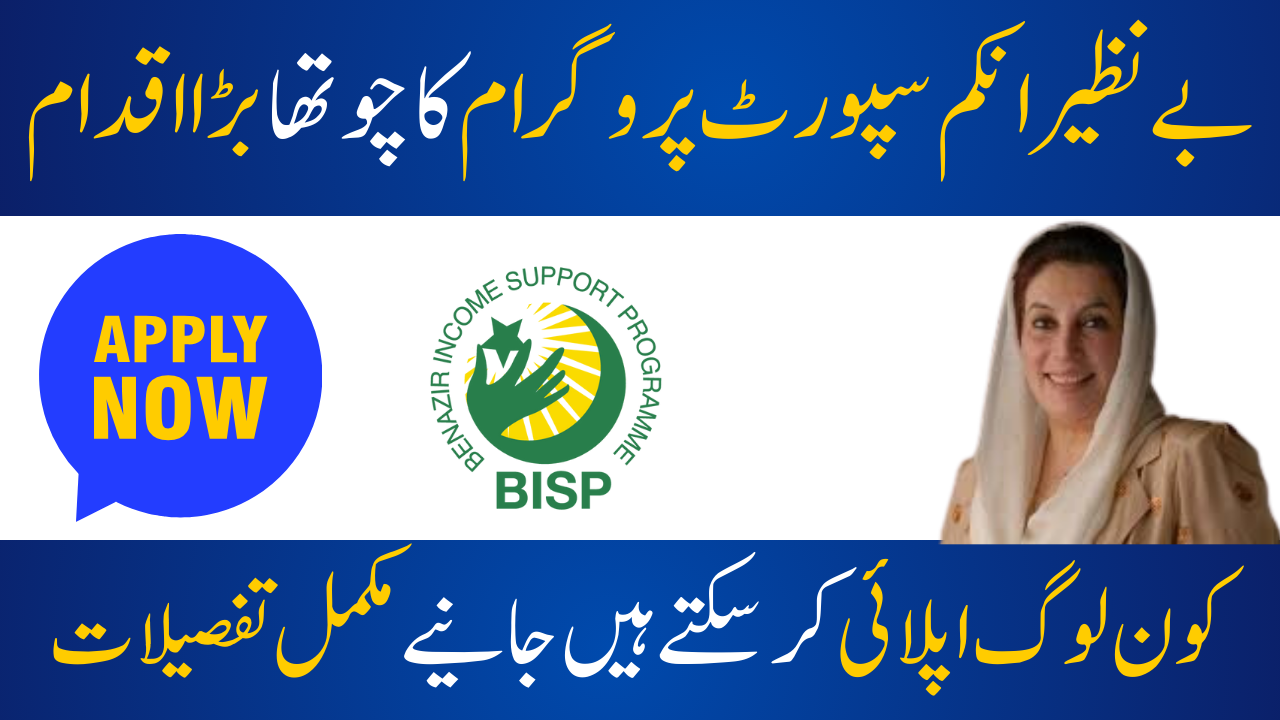BISP 4th Largest Initiative
The Benazir Income Support Program (BISP) has been a cornerstone of Pakistan’s social welfare agenda since its inception in 2008. With the aim of alleviating poverty and providing financial assistance to the most vulnerable segments of society, BISP has continuously expanded its reach and impact. In August 2024, BISP is set to launch its 4th largest initiative, further broadening its scope and benefits. This new initiative is expected to bring much-needed relief to millions of Pakistanis, particularly in the context of the country’s ongoing economic challenges. Here’s a detailed overview of the initiative, including who can apply, how to apply, and answers to frequently asked questions. BISP Extend Registration Date
Overview of the Initiative
The 4th largest initiative under BISP is designed to provide comprehensive financial support to low-income households across Pakistan. This program is part of the government’s broader strategy to enhance social protection measures and improve the living standards of the poor. The initiative will focus on:
- Cash Transfers: Regular cash payments to eligible families to help them meet basic needs such as food, healthcare, and education.
- Healthcare Assistance: Providing financial aid for medical treatments, particularly for chronic illnesses and maternal health. Payment of BISP Kafalat
- Educational Stipends: Encouraging school enrollment by offering scholarships and stipends to children from low-income families.
- Empowerment Programs: Initiatives aimed at women’s economic empowerment through skill development, vocational training, and microfinance opportunities.
Who Can Apply?
The eligibility criteria for this new initiative are aligned with BISP’s overall mission to support the poorest segments of society. However, specific requirements have been outlined to ensure that the most deserving individuals benefit from the program. BISP Cash Transfer
- Income Level: Applicants must fall below a certain income threshold, as determined by the Poverty Scorecard. The exact cutoff score may vary by region but generally targets households living below the poverty line.
- Gender: The program prioritizes women, particularly those who are heads of households, widows, or single mothers. This focus is in line with BISP’s commitment to empowering women economically.
- Family Size: Larger families with more dependents are given preference, especially those with young children, elderly members, or disabled individuals.
- Geographical Location: Rural areas and underserved urban regions are prioritized to ensure equitable distribution of resources across the country.
- Existing Beneficiaries: Families already enrolled in other BISP programs may be automatically eligible for this initiative, depending on their current status and needs.
How to Apply?
The application process for this initiative is designed to be straightforward, ensuring that even those with limited literacy or access to technology can apply without difficulty. Below are the steps to apply:
- Online Registration: Interested applicants can register online through the official BISP website or the Ehsaas Portal. A detailed form will need to be filled out, including information about household income, family members, and other relevant details. BISP 10500 Third Phase Payment
- In-Person Registration: For those without internet access, in-person registration is available at designated BISP centers across the country. Applicants can visit these centers with their CNIC and other required documents for assistance in filling out the application form.
- Verification Process: Once the application is submitted, it will undergo a verification process. This may include a visit from a BISP representative to assess the household’s living conditions and verify the information provided.
- Notification of Approval: Approved applicants will receive a notification via SMS or mail. They will then be required to visit the nearest BISP office or bank to complete the final steps of the registration process and receive their benefits.
- Appeal Process: If an application is rejected, there is an appeals process available. Applicants can request a review of their case by providing additional documentation or evidence of their eligibility.

Frequently Asked Questions (FAQs)
Q1: What is the main objective of BISP’s 4th largest initiative?
A1: The main objective is to provide financial assistance and support to low-income families, helping them to meet basic needs and improve their overall living conditions. The initiative focuses on cash transfers, healthcare assistance, educational stipends, and women’s empowerment.
Q2: How is this initiative different from other BISP programs?
A2: While this initiative shares similarities with other BISP programs, it is distinguished by its scale and scope. It targets a broader segment of the population, offers more comprehensive benefits, and includes new components such as enhanced healthcare assistance and empowerment programs for women.
Q3: Can men apply for this initiative?
A3: Yes, men can apply, but the program primarily prioritizes women, particularly those who are heads of households. However, in households where men are the sole breadwinners and meet the eligibility criteria, they can also benefit from the program.
Q4: Is there an age limit for applicants?
A4: There is no specific age limit for applicants. However, the program does prioritize households with elderly members, children, or disabled individuals.
Q5: How often will the cash transfers be made?
A5: Cash transfers are expected to be made on a quarterly basis, similar to other BISP programs. However, the frequency and amount may vary depending on the specific needs of the beneficiaries and available funding.
Q6: What documents are required to apply?
A6: Applicants will need to provide a valid CNIC, proof of income (if available), and any other documents that may be required for verification purposes, such as utility bills or medical records.
Q7: How will I know if my application is approved?
A7: Approved applicants will receive a notification via SMS or mail. They can also check their application status online through the BISP website or by visiting a BISP office.
Q8: What should I do if my application is rejected?
A8: If your application is rejected, you have the right to appeal. You can submit additional documentation or request a review of your case by contacting the BISP office.
Q9: Can existing BISP beneficiaries apply for this new initiative?
A9: Yes, existing BISP beneficiaries are eligible to apply. In some cases, they may automatically qualify for additional benefits under this initiative, depending on their current status.
Q10: Where can I get more information about this initiative?
A10: For more information, you can visit the official BISP website, contact the BISP helpline, or visit the nearest BISP office. Information is also available on the Ehsaas Portal.
Conclusion
The launch of BISP’s 4th largest initiative in August 2024 represents a significant step forward in Pakistan’s efforts to combat poverty and improve the livelihoods of its most vulnerable citizens. By providing targeted financial assistance, healthcare support, educational stipends, and empowerment programs, this initiative is poised to make a substantial impact on the lives of millions of Pakistanis. Eligible individuals are encouraged to apply and take advantage of the benefits offered by this groundbreaking program.
